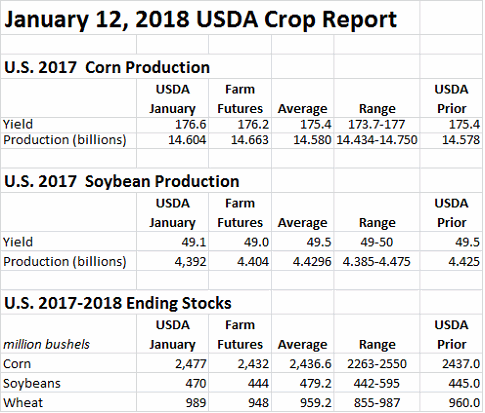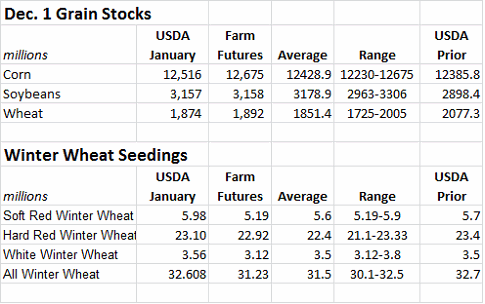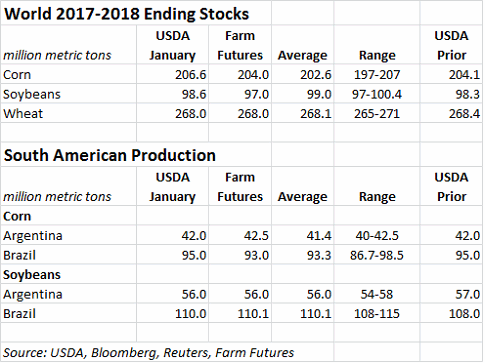January 12, 2018

Bearish news from USDA caused wheat futures to tumble immediately following the agency’s release of its January World Agricultural Supply and Demand Estimates (WASDE) report, as U.S. ending stocks moved 29 million bushels higher and 2018 acreage estimates came in higher than expected. Winter wheat prices cratered 2% to 3% after the report’s release, with spring wheat prices taking a more moderate hit of less than 1%.
“I went into this report believing markets were set to make significant moves today that should establish seasonal trends for rest of the winter,” says Farm Futures senior grain market analyst Bryce Knorr. “That appears to be what’s happening because USDA as usual delivered some surprises.”
Wheat feed and residual use for 2017/18 was lowered by 20 million bushels, and total supplies moved 5 million bushels higher based on higher imports. Production estimates remained unchanged. Acres for winter wheat clocked in at 32.608 million acres, which is the lowest in 99 years but still higher than analyst predictions.
World production for wheat moved 66.1 million bushels higher, as increased to Russian and Pakistan more than offset reductions in the EU. Russia also captured increased exports due to ample supplies plus competitive prices. Export reductions were reported in Australia and the EU, meantime.
“Wheat broke out of its month-long uptrend with a double dose of bearish news,” Knorr says. “Winter wheat seedings were higher than we expected, and the stocks report suggests even less wheat was fed than anticipated, despite some very cheap supplies available to the livestock industry.”
Prices may continue to struggle moving forward, at least until winter wheat crops emerge from dormancy later this spring, he adds.
Corn prices also reacted negatively to the January WASDE reports, with futures dropping around 0.6% after its release. USDA raised its production estimates of the 2017 U.S. harvest from 14.578 billion bushels to 14.604 billion bushels, after record-breaking yields of 176.6 bpa.
U.S. corn ending stocks moved higher, from USDA December estimates of 2.437 billion to 2.477 billion bushels. World ending stocks were also noticeably higher, moving from 8.0351 billion bushels to 8.1335 billion bushels.
“Corn yields came in close to our survey, though USDA cut harvested acres to ease the pain a little,” Knorr says. “As a result, corn supplies should remain burdensome, which should pressure prices lower into February.”
Rally ahead?
It’s possible the market could start talking about a rally to buy acres – prospect that is still a ways off, Knorr says. Also, exports could get a boost later in the marketing year, depending on the size of Brazil’s crop, but the focus will have shifted to new crop production by then.
Soybeans escaped the WASDE report with modest gains, meantime, trading 3 to 4 cents higher after its release. That’s partially due to USDA lowering its 2017 U.S. production estimates from 4.425 billion bushels to 4.392 billion bushels. Average yields were dropped slightly, from 49.5 bpa to 49.1 bpa.
U.S. soybean ending stocks for 2017/18 moved higher, however, from USDA December estimates of 445 million bushels to 470 million bushels. World ending stocks also edged higher, from 3.6119 billion bushels to 3.6229 billion bushels.
“USDA caught the funds leaning the wrong way into the report, and provided a mildly bullish surprise,” Knorr ways. “Yields are lower, as our recent survey found, but not enough to offset large supplies and slowing export demand.”
USDA is likely underestimating Chinese demand again, Knorr adds.
“They’re up more than 10% so far, while the government projects less than a 4% increase. But so far the bulk of those deals have come from South America, slowing U.S. sales. As a result, U.S. supplies will remain too big.”
USDA also reports on South American production – of particular interest at the moment, as the 2017/18 crop season is well underway there. Production estimates there remain a mixed bag for soybeans, with Argentina production slipping an estimated 36.7 million bushels, and with Brazil picking up another 73.5 million bushels. Corn production estimates for both countries were unchanged.



You May Also Like




